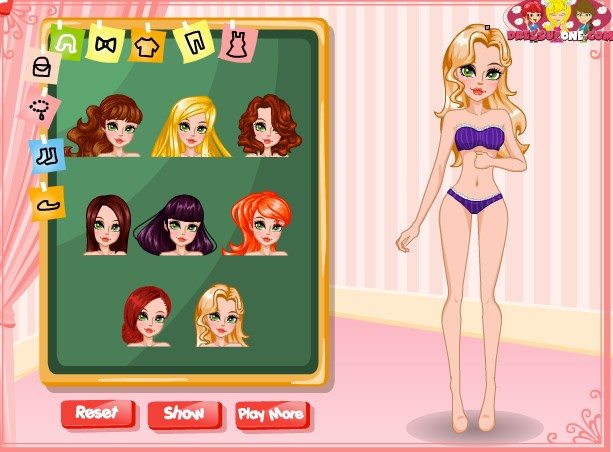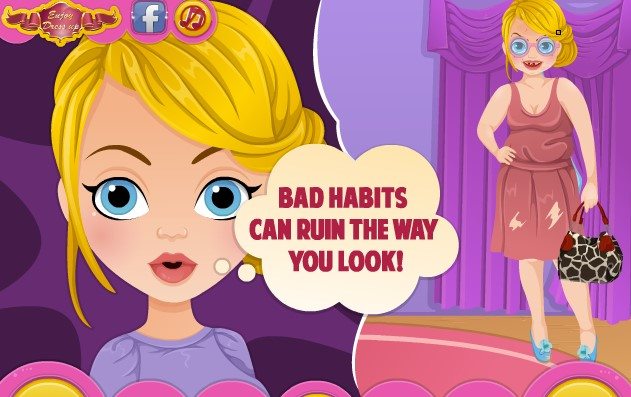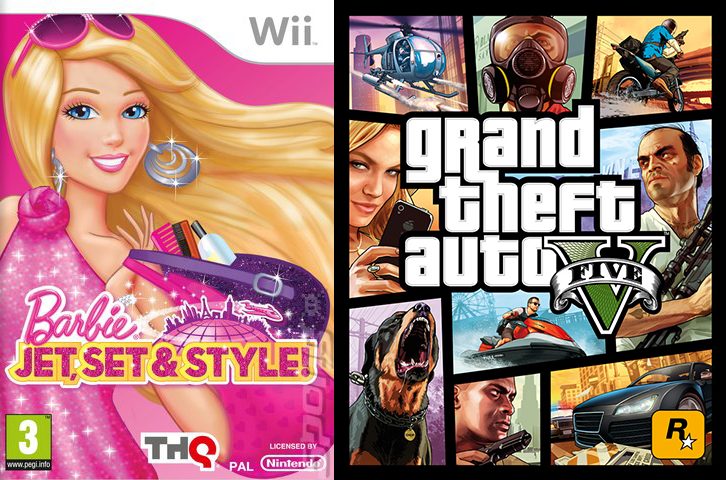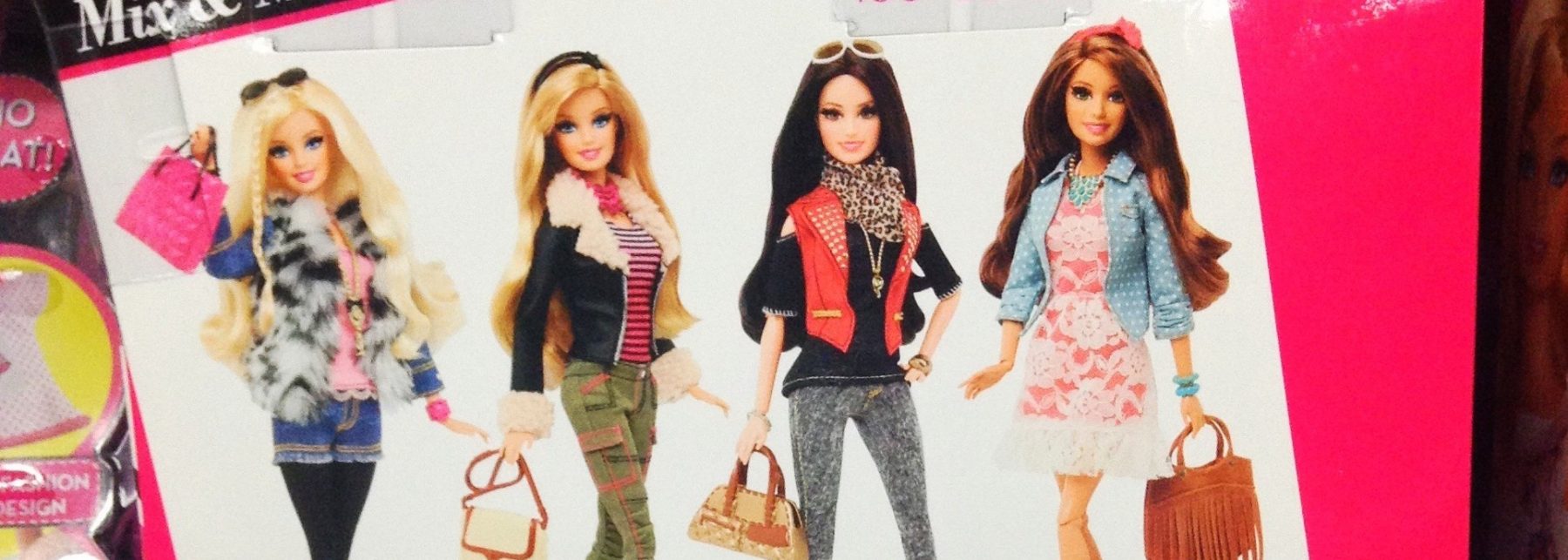Life in Plastic: Girls’ Games are Inflicting Expectations
Life in plastic, it’s fantastic. You can brush my hair, undress me everywhere. But that’s all you can do – except maybe cook.
[divider]
I’d be the first to admit that in my pre-teen years I spent hours upon hours on the girls’ section of games sites with My Scene being a personal favourite. Even as a seven year old with a blank canvas for a face and a schedule of napping over clubbing, there was something oddly fulfilling about decorating an avatar with slim-fitting dresses, six inch heels and more makeup than the cast of TOWIE so that she could hit a nightclub. Then, after that, why not bake an imaginary cake?
In retrospect though, whilst my rose-tinted spectacles and I were having a good old jolly time dressing Barbie and clan up, we were hopelessly naive to both the messages and standards being fed to young girls through such games.
Then, there are the buzzwords: beauty, makeover, princess, baby, ‘cutesy’, fairy, models and (worryingly) pin-up.
Flicking around on a girls’ gaming site today all I could make out were endless rows of stick-thin, big-eyed beauties luring girl gamers into their Stepford Wives-esque scenarios. Then, there are the buzzwords: beauty, makeover, princess, baby, ‘cutesy’, fairy, models and (worryingly) pin-up. It doesn’t matter if they’re not in a coherent order, so long as you have one or more of those words in your title you seem to qualify as an instantly attractive game to any young girl.
When you have a simple meander over these games though, and see just how much superficial tripe they are feeding girls about the standards of appearance they ‘should’ live up to, it’s no wonder that the recent ‘no make-up selfie’ trend has taken off as a bit different and breathtaking. I’m not at all against wearing makeup, but I think there’s a time and a place for its promotion, which is definitely not on a recreational site for little ones.
 The first game to fall both victim and perpetrator to my feminist values was ‘Most Popular Girl’, promoted by an hourglass shaped avatar with a thigh gap so impossible you couldn’t envy it if you tried – or, of course, wanted to. I’ve heard the argument before that models and Photoshop collaborate to set unrealistic standards for women in terms of appearance, and the case for that is equally evident in the ‘Most Popular Girl’ caricature. As for the game itself, it’s dry. There’s no aim or end goal. It merely offers an idealised cut-out for a session of dress up, and serves more as a promoter of the impossible, supposedly desirable look than a game.
The first game to fall both victim and perpetrator to my feminist values was ‘Most Popular Girl’, promoted by an hourglass shaped avatar with a thigh gap so impossible you couldn’t envy it if you tried – or, of course, wanted to. I’ve heard the argument before that models and Photoshop collaborate to set unrealistic standards for women in terms of appearance, and the case for that is equally evident in the ‘Most Popular Girl’ caricature. As for the game itself, it’s dry. There’s no aim or end goal. It merely offers an idealised cut-out for a session of dress up, and serves more as a promoter of the impossible, supposedly desirable look than a game.
Girls don’t need to be bombarded with idealised appearances, let alone learn what is perceived as unattractive. Children of any gender should be being filled with confidence and nurtured with the message that, in the words of Bruno Mars, they’re amazing just the way they are. And with this we move onto the game I love to loathe: ‘Reverse Makeover’. Its description essentially boasts a USP of letting gamers make a character look ugly. When you open it up, you’re first hit with the challenge of weight control and are instructed to feed the character chocolate and chips. I’m all for promoting a healthy diet but the line is crossed when the gamer is being informed of the ‘ugly’ character’s calorie count.
 Then, as the process unfolds the avatar’s teeth, skin and eyebrows are transformed into so-called unacceptable states, whilst she is also furnished with glasses – all major child insecurities. So what if someone’s skin is a bit blotchy or their teeth are not symmetrical? Let alone a child.
Then, as the process unfolds the avatar’s teeth, skin and eyebrows are transformed into so-called unacceptable states, whilst she is also furnished with glasses – all major child insecurities. So what if someone’s skin is a bit blotchy or their teeth are not symmetrical? Let alone a child.
The end product of the game in question is a cruel ‘before’ and ‘after’ picture with the prim and proper character we started off with saying, “bad habits can ruin the way you look.” Whilst I appreciate the idea of taking care of yourself, that really isn’t what this and all of the other girls’ games are about.
They’re just fostering the notion that to be beautiful you have to meet certain criteria and are forwarding this even more irresponsibly with actual representational graphics of what is beautiful and what is not. God forbid, if anyone looked frumpy, accessorised with leopard print or didn’t pluck their eyebrows. You or I may not find untrimmed facial hair or spare tyres attractive, but fundamentally beauty is subjective and not something that is or should be forwarded as one set of ideals.
Moreover, aside from offering girls the opportunity to play dress up in a certain, limited way, the only other alternatives involve cooking, cleaning, parenting, and – randomly – cute dogs. I needn’t expand on the issues here; they’re plain to see. Surely we’d prefer to see girl gamers out of the margin and active in whatever genre they see fit? My favourite game of all time (after Sims 2: classic) is Grand Theft Auto, which does – but shouldn’t – transcend expectations.
 Why should expectations for female gaming place something like Barbie over GTA?
Why should expectations for female gaming place something like Barbie over GTA?
The standard, dainty categories of dress-up and cooking exemplify the overarching problem with girls’ gaming well: there are too many expectations prevalent. It is a choice to wear makeup, to bake, to wear those shoes with that dress; yet, these simple choices are contained into one set, standard expectation throughout the scenarios, the graphics, the titles, and the peripheral genre as a whole. Life in plastic is just not fantastic.
[divider]
 We want to hear what you think about the expectations being forced upon women or men in gendered games. Tweet us @BoarGames!
We want to hear what you think about the expectations being forced upon women or men in gendered games. Tweet us @BoarGames!

Comments